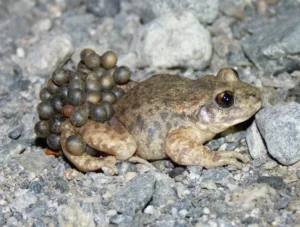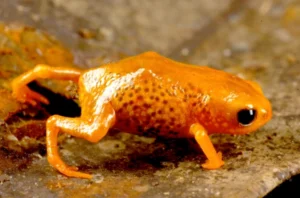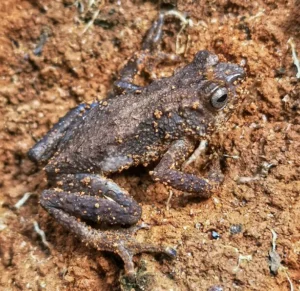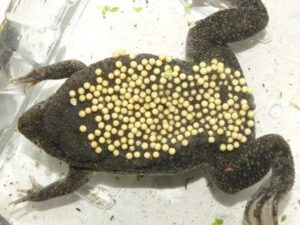Many people know that most frogs lay eggs in the water which then hatch into tadpoles, which develop into mature frogs over time. But have you ever wondered where toads lay their eggs?
Most toad species lay their eggs in shallow, fish-free, freshwater bodies. However, some species lay their eggs in moist, protected terrestrial environments, or retain the eggs inside their bodies and give birth to young fully-developed toadlets.
In a few toad species, such as the midwife toads, the males carry the fertilized eggs on their backs, to protect them from predators present in the water.
They keep the eggs moist by lying in damp places during the day and going into the water to swim if there is a risk of the eggs drying out.
When the eggs are ready to hatch, the male will detach them into a calm, shallow freshwater body, like a ditch, or a fishless pond.
Most Toads Lay Their Eggs in Bodies of Fresh Water
The majority of toad species lay their eggs in shallow, standing, or slow-moving freshwater bodies that are free of predatory fish. This could be in woodland ponds, seasonal pools, temporary rain puddles, flooded ditches, lake edges, river backwaters, bogs, marshes, swamps, and even in deep tire tracks or potholes filled with rainwater.
The eggs are usually laid in long strings (one to three eggs wide) along plants or resting on the pond bottom.

However, the eggs of some species, such as the eastern and the western narrow-mouthed toads are laid in small packets and form a single-layered film on the surface of the water.
Others, such as the red-spotted toad lay their eggs singly. The small eggs may adhere to each other and form small clusters on the pond’s bottom.
Oak toads lay their eggs singly or in small strands of up to six to eight eggs, either free-floating or attached to vegetation.
Toads generally prefer to breed in shallow, calm water, with very little, or no flow as their eggs could drift away otherwise. But a few species, like the Kra stream toad of Thailand, and the Japanese stream toad often lay their eggs in relatively fast-flowing streams.
Since these toads lay eggs in fast-flowing water, their tadpoles have suckers to cling to the rocks so they do not get washed away.
Some Toads Can Lay Their Eggs in Brackish Water
Frogs and toads have highly permeable skin (and eggs). For this reason, they typically depend on fresh water and will avoid salt water.
High salinity levels can be very highly dangerous, or even lethal to most frogs and toads. This is because salt tends to disrupt the water and ionic exchange across the permeable skin.
Frogs and toads are generally most vulnerable to salt in the embryo stage and experience very low survival rates in salt environments.
Since tadpoles usually can not change their habitats, adult toads select adequately diluted water bodies to lay their eggs, so the tadpoles can develop unharmed.

However, a few amphibian species can adapt to and tolerate saltwater habitats, especially those that live along the coast.
Toad species that are known to sometimes lay their eggs in brackish water include the following:
- Western Toad (Anaxyrus boreas)
- Yellow-Bellied Toad (Bombinatoridae Bombina variegata)
- Cane Toad (Rinella marinus)
- American Toad (Anaxyrus americanus)
- Fowler’s Toad (Anaxyrus fowleri)
- Southern Toad (Anaxyrus terrestris)
- Oak Toad (anaxyrus quercicus)
- European toad (Bufo bufo)
- Natterjack toad (Epidalea calamita)
- Berber Toad (Sclerophrys mauritanica)
- Balearic green toad (Bufotes balearicus)
- African green toad (Bufotes boulengeri)
- European green toad (Bufotes viridis)
These toads often live in coastal areas which get flooded by seawater, so they developed tolerance to brackish water as a survival strategy.
Some species of the Bufotes genus are even known to tolerate saline or even hypersaline water as long as any significant change in salinity is gradual. When moved directly from fresh to seawater, they usually die.
Midwife Toads Carry Their Eggs on Their Backs
Midwife toads are found in most of Europe and northwestern Africa. They get their name from the parental care they show for their eggs.

When mating, the female releases an egg mass embedded in strings of jelly. The male then releases his sperm and inseminates the egg mass – then he pulls the egg mass so that he can wrap the strings around his waist and back legs.
Once the egg mass is wrapped, he can mate again – and carry up to 3 clutches, totaling about 150 eggs.
When mating is complete, the female leaves, and the male carries the eggs with him on land until they are ready to hatch, in about 6 weeks.
The male will keep the eggs moist by lying up in damp places during the day, and going into the water if the eggs risk drying out. He will also produce a skin secretion that protects the eggs from infection.
When the eggs are ready to hatch, the male wades into a shallow body of fresh water, and releases the tadpoles. Often, the tadpoles are released into permanent water bodies, because they may overwinter before they complete their development in spring.
Some Toads Lay Eggs on Land
A few South American, and African toad species lay their eggs on land rather than in the water. The exact location the eggs will be laid depends on the toad species.
For example, Ethiopian mountain toads (Altiphrynoides malcolmi), lay their eggs near streams, or pools.
Unlike most other toads, Ethiopian mountain toads fertilize their eggs internally, then the female lays about 20 eggs enclosed in a mucus layer. The eggs are deposited either in the vegetation, under logs, or in leaf litter.
When the tadpoles hatch, they will not feed, but will instead be nourished by the large yolk-sack of their eggs, until they complete metamorphosis in a few weeks.
Saddleback toads (Brachycephalus) on the other hand, lay their eggs away from the water. They lay about 5 eggs in a hidden location, like under a tree log, or in leaf litter on land.

The female then rolls the eggs until they are covered in particles, making them blend in with the soil where they have been laid. It may also protect the eggs from drying out.
The eggs hatch into young fully developed toads with no tadpole stage.
Some Toads Give Birth to Live Young
Some toads live in very harsh environments. For this reason, they developed reproductive behavior that allows them to live, and successfully breed in these environments.
These toads retain the eggs inside their bodies until they hatch, and then give birth to young fully-developed toads. This is known as “Ovoviviparity.”

One study found that toads that do not have a tadpole stage almost always lived in environments with steep terrain and low availability of accumulated water sources. The lack of a tadpole stage is necessary for the survival of their species.
A few toads without a tadpole stage include the following:
- Kihansi spray toad (Nectophrynoides asperginis)
- Pseudo forest toad (Nectophrynoides pseudotornieri)
- Frontier forest toad (Nectophrynoides frontierei)
- Smooth forest toad (Nectophrynoides laevis)
- Minute tree toad (Nectophrynoides minutus)
- Tornier’s Tree Toad (Nectophrynoides tornieri)
- Morogoro tree toad (Nectophrynoides viviparus)
- Uzungwe Scarp tree toad (Nectophrynoides wendyae)
- Vestergaard’s forest toad (Nectophrynoides vestergaardi)
- Wide-headed viviparous toad (Nectophrynoides laticeps)
- Western Nimba toad (Nimbaphrynoides occidentalis occidentalis )
- Liberia Nimba toad (Nimbaphrynoides occidentalis liberiensis)
The Toads That “Give Birth” Through Their Backs
Surinam Toads are a fully aquatic frog species from the northern Amazon basin of South America. These toads are unique, in that the female gives “birth” to the young out of her back!
The female releases about 100 eggs during mating. Next, the male fertilizes the eggs and pushes them into the female’s back – and the skin of the female then encloses the eggs.

The embryos will develop to the tadpole stage inside of their egg pockets but will remain until they complete their development and become toadlets in about three to four months.
Once the eggs hatch, fully formed toads will pop out of the female’s back.
Frequently Asked Questions:
Do toads lay eggs in water?
Most toads lay their eggs in the water. These eggs are usually laid in long strings of jelly about one to three eggs wide and are attached to plants, or rest on the pond bottom. Some species such as the eastern and western narrow-mouthed toad lay their eggs in a surface film on the water’s surface.
Do toads lay eggs on land?
Most toads lay their eggs in the water. However, a few species such as the Ethiopian mountain toad lay their eggs on land near streams, or pools of fresh water. The eggs are laid in vegetation, under logs, or, in leaf litter. When the tadpoles hatch, they live entirely off the yolk of their eggs.
Do toads give birth to live young?
Most toads reproduce by laying eggs, but a few African toad species give birth to live young. They retain the eggs inside their bodies until they hatch, and then give birth to young fully-developed toads. This is known as “Ovoviviparity.”
Conclusion
Toads are found on every continent, excluding Antarctica. With this wide distribution, they live in a very wide range of habitats, from humid forests, to dry regions.
Most toads lay eggs in water, which hatch into tadpoles, and metamorph into adult toads over time.
However, a few toad species have adapted breeding strategies that are more practical for the areas they live in.
These toads either lay their eggs on land or retain their eggs inside of their bodies until they hatch – and then give birth to fully developed toads without a tadpole stage.
Photo credit: Danielle Brigida (CC BY 2.0)


